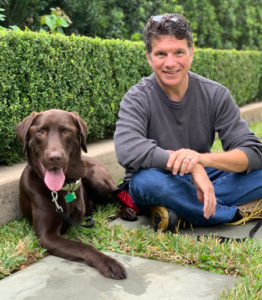
Michael Baugh CDBC CPDT-KSA
I saw my last in-person client on March 18th 2020. A week later my partner, Tim, and I had a hard talk about how long we could keep Michael’s Dogs afloat. Could we keep it afloat, period? Were we built to survive a pandemic? After all, in-home dog training and behavior consulting is close-contact work. It’s house-to-house work, in the living room work, passing treats and handing off the leash work. In other words, it’s potentially dangerous work.
My Dad was an entrepreneur. He was a child of the depression who reinvented himself more times than I can count – from hard times to good times to the best of times. He passed away in 2014. And, in those early days of April 2020 I missed him desperately. I pulled from memories and stories he shared through the years looking for inspiration – for advice – for answers. What would Dad do?
Victoria Thibodeaux had joined me in the group in January. It was just the two of us then. We talked every day that Spring. I told her that my dad had taught me that when the business is slow you work on the business. So, Victoria and I worked on the business and we worked hard – trying out ideas, taking on projects, pushing the company hard into the waves that

threatened to sink us. We launched online classes, including Puppy Socialization in a Time of Social Distancing and a prep course for clients working with aggressive dogs. And we started using Zoom for Live Video Consultations.
All the while, there was a voice in my heart (perhaps it was Dad) leading us back again and again to our core values. Our mission is to help people who are suffering with their dogs. The world was changing, yes. But, the mission wasn’t.
KTRH News Story: Dog Training As a Small Business – Reimagined
I’d done online dog behavior consolations before. Victoria and I literally transitioned to doing them exclusively overnight. The first one was March 19th 2020. As of this writing we’ve done over a thousand Zoom consultations and resolved scores of complicated cases start-to-finish. We’ve had clients in Houston, of course. But, our service area quickly became all of Southeast Texas and beyond. We’ve helped families with their dogs in Austin, San Antonio, Phoenix, Los Angeles, Seattle, Rural Missouri, Suburban Washington D.C., and more.
Of course, we weren’t the only ones. This was an industry-wide shift. The International Association of Animal Behavior Consultants (IAABC) launched a campaign to provide behavior consultants with useful resources for making the transition to online work. The Association of Professional Dog Trainers (APDT) and The Pet Professional Guild (PPG) followed with similar efforts.
I won’t say that the pandemic has been a good thing for any of us. As the months added up, so too did the friends, clients, and colleagues who fell ill. My niece, an intensive care nurse, got a bad case of Covid and spent a night in the hospital herself (she’s recovered). Another dear friend in the dog community has permanent complications. We’ve all suffered in some way, even if only from the isolation and the drudgery of it. But I will say this: our mission to help people and their dogs has seen us through even the hardest days.

Some folks were hesitant about doing the training online at first. But, we’ve learned that the benefits of online dog training are actually greater than we’d imagined. We’ve been able to help more people and dogs than I ever thought possible (twice as many clients in 2020 than we helped the year before). To meet that need we added two additional certified dog behavior professionals, Erin Richardson CPDT-KA and Jeannie Seuffert CDBC, as well as an assistant, Everett Lowenstein. Hard as this year has been, it has also been the most thrilling and fulfilling year of my professional life.
Do we miss seeing our clients in person? Yes, of course. We especially miss that close contact with dogs (even the ones who appear they want to hurt us at first – haha). And, yes, we will return to that work as soon as we can. Our plan is to start seeing clients in their homes again as soon as each of us is vaccinated. But we won’t just go back to “business as usual.” This pandemic has taught us too much for that. We will continue to offer live video consulting online even after the pandemic. As I sometimes like to say, it’s not an either-or proposition. It’s a yes-and one. The benefit for clients of online dog behavior consulting is just too great to abandon it. We’ll be able to help people far beyond our boundaries, as we are now. And we’ll be able to help our local clients and their dogs more efficiently with a combination of online and in-person options.
We have learned so much these past few months. Personally, I have learned how important human connections really are both personally and professionally. I think we can all relate to that. There was a real fear that physical distancing and isolation would break those connections. But, here’s the most beautiful thing I’ve learned. Humans always find a way. We’ve been able to connect in new ways. We’ve forged new relationships. We have held close the connections that mattered most to us. And, we’ve grown even closer to the people we love.
Because that’s what we do. Turn into the storm, head high above the water, towards the rising sun and the new year ahead.
Michael Baugh teaches dog training in Houston, TX. He specializes in aggressive dog training.



